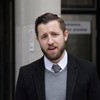An USAF MQ-9 Reaper. Image by General Atomics
Canada is looking at buying its own weaponized drones, and internal documents tout the benefits of a controversial model used by the US Air Force.American Reaper and Predator drones have dropped Hellfire missiles on terrorist targets all over the world for years, but Canada has kept its distance from the cutting-edge weapons — until recently.A February 2015 Canadian ministerial briefing, obtained through Canada's Access to Information Act and classified as "Secret," offers a glimpse at how the upper echelons of the Department of National Defense view armed drones, which were known to be on the air force's shopping list.As far back as the airstrikes in Libya in 2011, senior officers within the Canadian Air Force (CAF) hoped the operation could kickstart a $600 million procurement of new drones with weapons payloads. Canada has only ever rented surveillance drones, even during the Afghan mission when the CAF operated leased Heron surveillance drones from MacDonald Dettwiler and Associates, a partner of Israel Aerospace Industries."Department of National Defence/Canadian Armed Forces [DND/CAF] has used several different UAVs in recent operations, and is currently examining a range of options for providing future UAV capabilities," the briefing says, using a common acronym for Unmanned Aerial Vehicles. "Building upon its experience operating UAVs in Afghanistan and other theaters, DND/CAF is working to procure a range of different types of UAV systems in the coming years."The briefing argues "UAVs offer several advantages that manned aircraft cannot provide," and are an "economical" technology. Namely, the briefing compares current Canadian aircraft, including fighters carrying missiles and bombs, with drones used by the US Air Force for its top secret operations."The General Atomics MQ-9 Reaper can remain aloft for over 27 hours compared to a maximum of 17 hours for CP-140 Aurora or less than 3 hours for a CF-18 Hornet — UAVs provide a sustained presence over an area," says the briefing. The Aurora is a long-range patrol and surveillance aircraft, while the Hornet is the fighter-bomber Canada uses in its current airstrikes against the Islamic State.The MQ-9 Reaper is used by American forces to drop Hellfire missiles on targets, and is indeed the model responsible for killing infamous Islamic State militant Mohammed Emwazi, known as "Jihadi John". The mere mention of the Reaper represents a rare moment when the Canadian government actually names a possible model of weaponized UAV.And it is the weaponization of a drone, the briefing explains, that sets the aircraft apart by providing not only an intelligence and surveillance advantage, but precision strike capabilities for coordinated attacks with special operations forces on the ground."In addition, UAVs can also be fitted with weapons or other stores to provide a range of effects. For example, after providing Intelligence Surveillance and Reconnaissance [ISR] for hours above the battlefield, UAVs would be positioned to provide an immediate precision strike in support of ground forces on a deployed operation," the briefing explains.Since the early 2000s, Canada's Joint Unmanned Surveillance Targeting and Acquisition System (JUSTAS) program has tried to identify an effective UAV platform with both surveillance and strike capabilities that meets the needs of the armed forces.Critics say the decision to acquire weaponized drones for the first time must be made carefully."Any consideration of such an acquisition should be done in the full light of day, as part of the urgently needed public and parliamentary review of defense policy," said Peggy Mason, President of the Rideau Institute, a non-profit Canadian think tank that has been critical of armed drones and Canada's potential purchase of aircraft like the Reaper. "This would be particularly true in the case of drones that might be considered for offensive purposes. Weaponized drone acquisition should be made transparently."But the specter of new conflicts away from the Middle East might be a driving force behind the ultimate procurement of UAVs for Canada. The briefing also outlined the need to procure drones with not only "survivability, lethality, and flexibility" but ones that are able to operate in harsh Arctic air, noting that the remote and austere environment raises "significant difficulties".Scientists at Defense Research and Development Canada, a government agency, have already begun investigating the potential for unmanned robotics to support troop operations in the Arctic, given the region's geopolitical importance and its northern neighbor.It is no secret Russian President Vladimir Putin values the Arctic region as a strategic region for future resource extraction. To support those plans, Putin has commissioned an Arctic drone base in nearby Siberia. Meanwhile, Russian heavy bombers have flown provocatively near Canadian airspace in a tit-for-tat standoff with Canada over Arctic borders.Recent provocations aside, both the Arctic and armed drones are on the radars of Canadian policymakers as the search for a new drone fleet continues."That decision has not yet been made," said Captain Alexandre Munoz, a spokesperson for DND.And although the secret briefing document specifically names the MQ-9 Reaper in comparison to current manned CAF aircraft, Munoz maintains DND "will not comment on any one supplier, make or model" because it would undermine the competitive procurement process.Follow Ben Makuch on Twitter: @bmakuch
Advertisement
Advertisement
Advertisement
